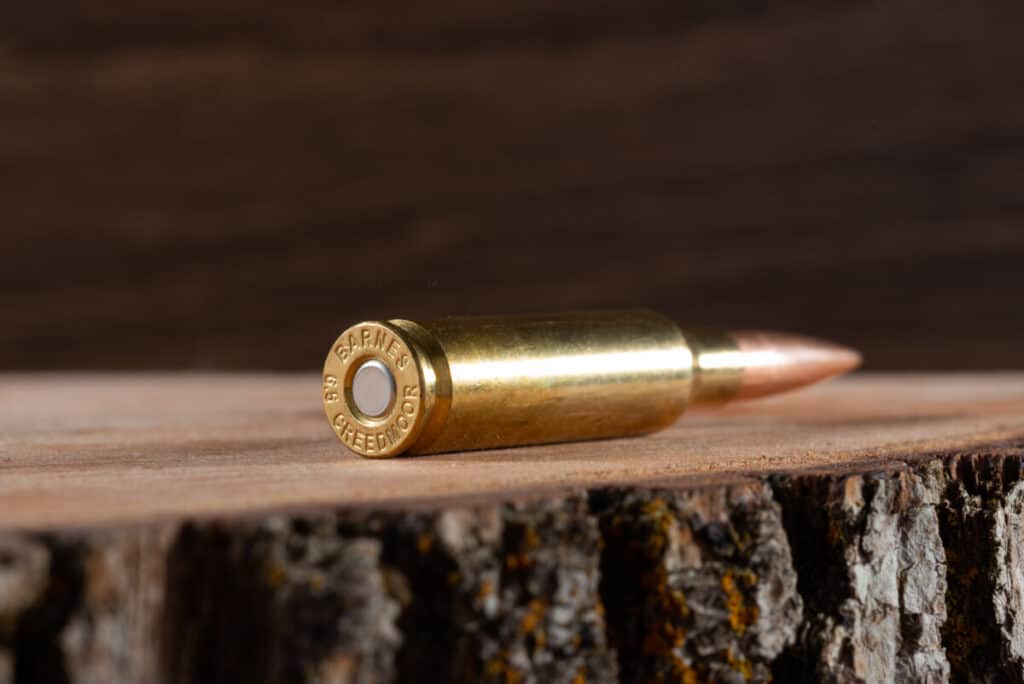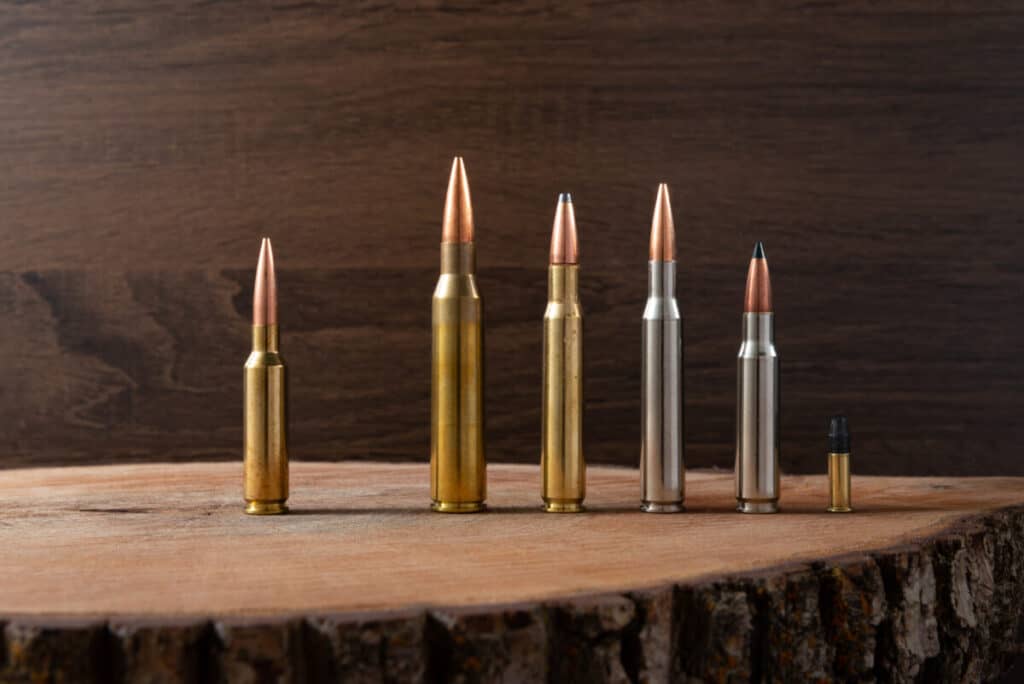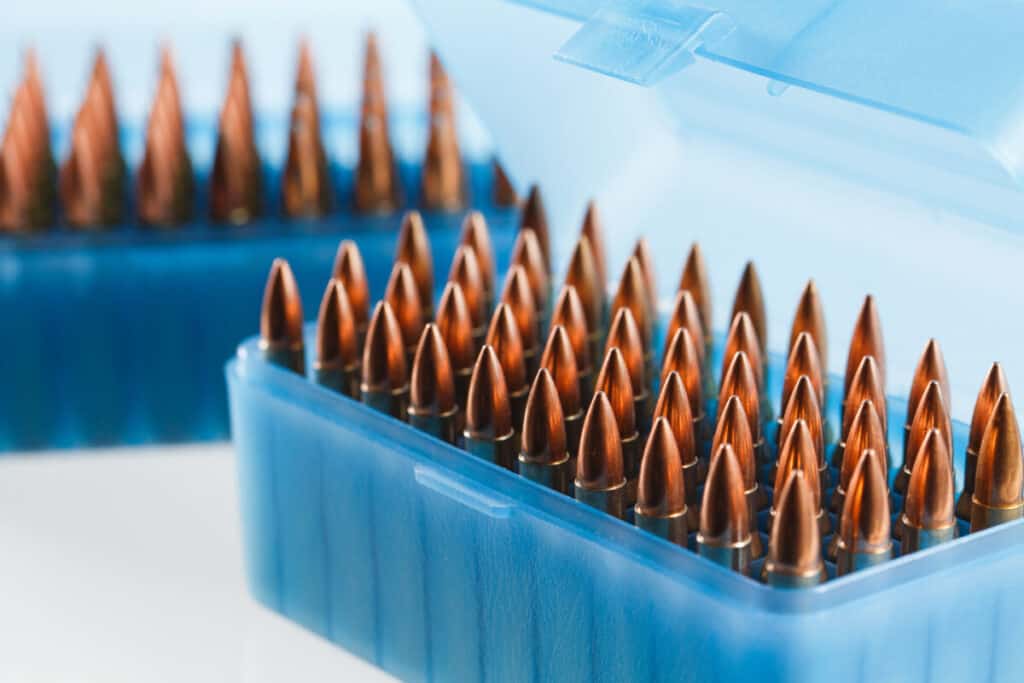Comparing the 6.5 Creedmoor to 5 Similar Cartridges

Cartridges that fire 6.5 millimeter (.264 Caliber) bullets are wildly popular today with none more so than the 6.5 Creedmoor. The 6.5 Creedmoor was not the first or most recent cartridge to be introduced while slinging 6.5 mm bullets, but it is the most popular to do so.
People love the 6.5 Creedmoor because the cartridge can fire moderately weighted bullets with high ballistic coefficients, generating lethal energy levels out of a short-action rifle with mild recoil.
This article will not only explain why the 6.5 Creedmoor is so successful, but it will also compare the Creedmoor with some similar, even venerated cartridges.
The Contenders
The contenders are two more 6.5 mm cartridges, 260 Remington and 6.5-284 Norma; and then we compared cartridges of varying bullet calibers, the .25-06 Remington (.25 caliber), .270 Winchester (.27 Caliber), and .308 Winchester (.30 Caliber). By comparing the 6.5 Creedmoor with cartridges that are not .26 caliber we can begin to glean why the 6.5’s are so popular.
Below you will find a chart comparing the cartridges in five key categories.
| Cartridge | Bullet Weight | Muzzle Velocity | Energy at 200 Yards | Ballistic Coefficient | Recoil | Action |
| 6.5 Creedmoor | 120-143 Grains | 2600-2700FPS | 1650-1850ft-lbs | .485-.646 | 12lbs | Short |
| 260 Remington | 120-143 Grains | 2600FPS | 1650-1700ft-lbs | .485-.580 | 13lbs | Short |
| 6.5-284 Norma | 120-143 Grains | 2600FPS | 2000ft-lbs | .510-.646 | 14.5lbs | Short |
| .25-06 Remington | 120 Grains | 2800FPS | 1450-1640ft-lbs | .394 | 12.5lbs | Long |
| .270 Winchester | 130-150 Grains | 2600-2700 FPS | 1575-2140ft-lbs | .460-.536 | 17lbs | Long |
| .308 Winchester | 130-180 Grains | 2400-2600 FPS | 1740-1930ft-lbs | .295-.530 | 18lbs | Short |
The Takeaway
Like all of the choices we make regarding rifle and cartridge selection, the application for which you plan to use the rifle should be the ultimate deciding factor. Do you want one gun that can take deer at ranges out to 500 yards while also being a viable long-range competition gun?
Then the 6.5 Creedmoor, with its light recoiling, high velocity, accuracy, and energy, is as good as any choice on this list.
If you plan to hunt elk or other, larger-bodied game species at ranges to 500 yards, you may want to consider the 6.5-284 Norma or .270 Winchester. Other than versatility, there is nothing the .308 Winchester does better than the 6.5 Creedmoor.

6.5 Creedmoor
The 6.5 Creedmoor has become one of the most beloved cartridge choices in the United States for good reason as you can see from the chart above. Accurately firing bullets in a caliber and weight that are excellent for most of North American big game, the 6.5 Creedmoor also boasts better than tolerable recoil statistics.
In fact, the 6.5 Creedmoor has the lightest expected recoil of the six cartridges compared here. This same, light recoil offers target shooters a flat flying cartridge that does not beat them up at the range.
The 6.5 Creedmoor is as well suited for whitetail or mule deer hunts as it is for long-range target competitions.
Another factor that influences the popularity of the 6.5 Creedmoor is that it runs in a short-action rifle, allowing for shorter, lighter-weight guns. Rifle weight becomes of primary concern when selecting a backcountry rifle though, for bench rest competitions where the 6.5 Creedmoor also makes its home, a heavier gun may be a benefit.
In the chart above you will see two other 6.5mm cartridges: the 260 Remington and the 6.5-284 Norma. These three cartridges fire the same bullets, only out of different cases. The numbers for all three 6.5’s are close and all three in some ways outperform the other three cartridges on the list.
The primary reason the 6.5’s (and the 6.5 Creedmoor more than the others), are so effective and have become immensely popular is their ability to fire bullets with high ballistic coefficients.
The ballistic coefficient of the bullet is basically a measurement of the bullet’s ability to overcome drag and wind deflection. 6.5mm or .26 caliber bullets do this as well as, if not better than most. A bullet’s ballistic coefficient is influenced by its weight, sectional density (cross-section size), and shape.
At .264 of an inch in diameter, the 6.5mm bullet exists in a sweet spot where manufacturers can increase bullet length without going too heavy.
By increasing the ogive (the tapered point) at the front of a bullet and increasing the overall length of the bullet, manufacturers can produce projectiles with higher ballistic coefficients. The narrower point helps cut through the air at a better rate while moving much of the weight from the tip of the bullet further back keeps the same weight and perhaps more velocity and energy.
When hunting, bullet energy is a prime way to judge cartridge efficacy. The acceptable, ethical numbers that we work with here at Backfire are 1000ft-lbs for deer and 1500ft-lbs for elk.
Of course, deer and elk can be killed by cartridges that put up less energy, but these numbers should allow a hunter more confidence in the lethality of their chosen cartridge. As you can see, at 200 yards, the 6.5 Creedmoor reaches energy numbers well surpassing those needed to take elk.
In fact, all six cartridges on this list do. The Creedmoor comes in at fourth on this list, falling behind the two long action cartridges, the .30 caliber cartridge, and surprisingly another 6.5, the 6.5-284 Norma.
The velocity and energy levels generated by the 6.5 Creedmoor, as well as the other cartridges in this comparison, mean that they are all effective beyond 200 yards on game. The Creedmoor surpasses 1200ft-lbs at 500 yards. Using our ethical energy levels, this means that the 6.5 Creedmoor has more than enough energy for medium sized ungulates out to 500 yards.
It is at these longer ranges where the 6.5 Creedmoor and the higher ballistic coefficient bullets it fires really makes up ground on the other, non-6.5 cartridges because the higher b.c. numbers truly make the difference at distance. Again, the ballistic coefficient measures the bullet’s ability to cut through the atmosphere and deflect wind resistance; meaning a higher b.c. indicates more speed and more accuracy at longer ranges.
The other 6.5’s on this list use the same high b.c. bullets, and are otherwise impacted by the cartridge case’s powder capacity and barrel twist rate. As you will see, the 6.5 Creedmoor surpasses the 260 Remington and the 6.5-284 Norma in muzzle velocity, comes in second of the three in energy, and has the least amount of recoil. The differences, however, are fairly small.
Truthfully, the 6.5 Creedmoor may surpass the other 6.5’s in muzzle velocity, but not necessarily. The 6.5 Creedmoor has the ability to be loaded to faster speeds than the other two 6.5’s but you probably will not see that in factory ammunition.
At 1-3 lbs difference in recoil, though the Creedmoor is the softest recoiling cartridge of the three, it isn’t by much. In similarly weighted rifles, the felt recoil differences are negligible.

260 Remington
The 260 Remington, which was released a decade before the 6.5 Creedmoor, is based on the .308 Winchester necked down to accept 6.5mm bullets. Like the other 6.5’s on this list and its parent cartridge the .308 Winchester, the 260 Remington fits in a short action rifle. The 260 Remington is an effective backcountry cartridge used in lighter rifles with mild recoil.
Though the muzzle velocity of the 260 Remington is comparable to the other cartridges on this list, the round impacts with the second-worst energy levels (up to 1700ft-lbs at 200 yards).
In fact, at 500 yards, the 260 Remington retains less than 900ft-lbs of energy.
The low energy level means the 260 Remington cannot compete with the 6.5 Creedmoor in either long-range hunting or target shooting. The 260 Remington may kill elk at closer ranges but even for whitetail or mule deer, no shots beyond 400 yards should be considered based on our energy baselines.
Of the three 6.5’s on this list, the 260 Remington is the most anemic hitting cartridge.
6.5-284 Norma
Based on the intriguing 284 Winchester cartridge, the 6.5-284 Norma is a true performer both in long-range competition and afield. Like the other 6.5’s on this list, the 6.5-284 Norma fits in a short action rifle, is capable of firing high b.c. bullets, and reaches muzzle velocities that indicate an accurate, flat-shooting cartridge.
Where the 6.5-284 Norma shines though and surpasses the 6.5 Creedmoor, is energy.
Hitting with 2000ft-lbs of energy at 200 yards, the 6.5-284 Norma surpasses the Creedmoor by at least 150ft-lbs. Reaching energy levels above 1500ft-lbs at 500 yards, the 6.5-284 Norma should be considered a long-range hunting cartridge as well as a competition cartridge (where shooters tune the round to hit at 1000 yards).
An additional 300ft-lbs of energy at 500 yards over the 6.5 Creedmoor is truly something to consider.
Of the three 6.5’s on this list, the 6.5-284 Norma does hit with the highest recoil, but again, the differences are minimal. The true concern for the 6.5-284 Norma is that few rifle manufacturers chamber rifles for the cartridge. Savage and Christensen Arms both do, however, and ammo is manufactured by premier ammunition companies such as Nosler.
Handloading the cartridge will produce the best results, with an array of bullet selections thanks to the overall popularity of 6.5mm cartridges and production brass available from Lapua, Nosler, Hornady, and Norma.
| Cartridge | 500 Yard Energy | Application |
| 6.5 Creedmoor | 1200ft-lbs | Deer/Target |
| 260 Remington | 900ft-lbs | Target |
| 6.5-284 Norma | 1500ft-lbs | Elk/Deer/Target |
| .25-06 Remington | 1000ft-lbs | Deer/Antelope/Target |
| .270 Winchester | 1600ft-lbs | Elk/Deer/Target |
| .308 Winchester | 1300ft-lbs | Deer/Target |
.308 Winchester
Let’s stay with short action length cartridges for this next offering, the .308 Winchester. Yes we jump a couple of calibers to a .30 caliber projectile, but the popularity and availability of the .308 Winchester both in ammunition and rifles almost demands we consider it.
The .308 is a versatile cartridge able to load bullets that cover a wide range of weights.
Not all of those bullets however reach quality ballistic coefficient numbers, showing that the .308 may not be as accurate at longer ranges as the 6.5’s on this list. Energy levels with .30 caliber bullets are slightly better than the 6.5 Creedmoor though muzzle velocities are roughly the same.
Coming in with around 1300ft-lbs of energy at 500 yards, the .308 Winchester edges out the Creedmoor again. But again, not by much at 100ft-lbs more energy than the Creedmoor at 500 yards.
Though not enough to be prohibitive, the .308 Winchester has the most felt recoil of the cartridges on this list and with a generally heavier bullet, drops at a faster rate than any of the 6.5’s. The .308 Winchester is an excellent cartridge, but at closer ranges where it is most effective, it does not surpass the 6.5 Creedmoor in any great way.
If you are a long-range hunter, there are more reasons to go with a 6.5 over the .308 Winchester.
The Long Action Choices
.25-06 Remington
The smallest caliber cartridge in this comparison, the .25-06 is based off of the .30-06 cartridge necked down to accept .25 caliber bullets. The .25-06 is the true loser in this comparison, generating the lowest energy levels (200ft-lbs less than the Creedmoor) while firing bullets with the lowest ballistic coefficient.
Though shot from a long action with plenty of room for powder, the .25-06 has just enough energy to ethically take elk at 200 yards but barely surpasses 1000ft-lbs at 500 yards. You do get a mild recoil from the .25-06, though still more than the 6.5 Creedmoor. Muzzle velocities are high, but bullet choice is minimal and general ballistic coefficients low. This is based on the smaller weighted bullets and barrel twist rates.
Speed is the one category where the .25-06 beats not only the Creedmoor, but all of the cartridges on this list; though speed drops quickly at longer distances. Within 300 yards, the .25-06 performs well enough to be considered a deer cartridge but it is best used for smaller game and varmint. In long range competition, the .25-06 does not compete with the 6.5 Creedmoor.
.270 Winchester
I am a traditionalist, there is no doubt, and I love the .270 Winchester with its reputation as a flat-shooting cartridge. Like the .25-06, the .270 Winchester gets its origins from the .30-06 and is therefore found in long-action rifles.
With today’s manufacturing technology, you can get ultralight rifles chambered for long action cartridges, but short action rifles have a head start at shaving overall rifle weight.
The .270 Winchester matches the 6.5 Creedmoor in muzzle velocity and comes out as the winner in energy among all of the cartridges on this list. The .270 Winchester can also be loaded with high b.c. bullets, though not as high as the 6.5’s.
With more than 1600ft-lbs of energy at 500 yards, the .270 Winchester is both ethical and effective on elk-sized game at that range.
Recoil may be a consideration, as the .270 Winchester has more recoil than all of the cartridges on this list except the .308 Winchester.
A Winner Crowned
Below is a chart to help us illustrate the winner in this cartridge comparison. I ranked each cartridge from best to worst (1-6), with ties acceptable. For the difference in action length, short action cartridges receive a 0 while long action cartridges receive a 1.
The lowest overall score wins this comparison.
| Cartridge | Bullet weight | Muzzle Velocity | Energy | B.C. | Action | Total |
| 6.5 Creedmoor | 3 | 2 | 4 | 2 | 0 | 11 |
| 260 Remington | 3 | 3 | 5 | 3 | 0 | 14 |
| 6.5-284 Norma | 3 | 3 | 2 | 1 | 0 | 9 |
| 25-06 Remington | 4 | 1 | 6 | 6 | 1 | 18 |
| .270 Winchester | 2 | 2 | 1 | 4 | 1 | 10 |
| .308 Winchester | 1 | 3 | 3 | 5 | 0 | 12 |
Based on this comparison, the 6.5-284 Norma wins due to its retained downfield energy, ample muzzle velocity, and its ability to fire high b.c bullets; making the 6.5-284 Norma equally adept as a hunting and long-range competition cartridge.
The 6.5 Creedmoor comes in third behind the venerated .270 Winchester which itself gets a boost in this comparison due to the heavier bullets in .27 caliber.

